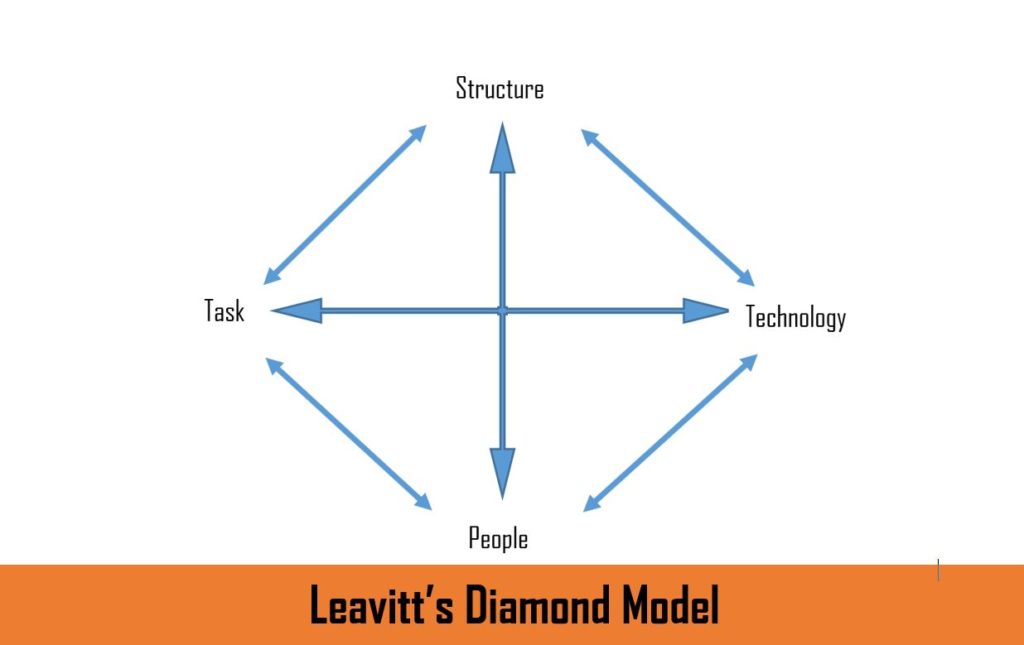Leavitt’s Diamond model of change management is a framework that provides a holistic approach to managing change within an organization.
Developed by Harold J. Leavitt in the 1960s, the model recognizes that successful change requires consideration of four key elements: people, tasks, structure, and technology.
The model suggests that changes made to any one of these elements will have a direct impact on the others, and that managing change effectively requires a balance between them.
The Leavitt’s Diamond model has since become a widely-used tool for change management professionals, as it provides a clear and practical framework for analyzing the different aspects of an organization and planning change initiatives.
In this blog post, we will explore the Leavitt’s Diamond model of change management in detail, discussing its importance and how it can be applied in practice to help organizations navigate the challenges of change.
What is Leavitt’s Diamond?
This model revolves around four components of organizational change and these elements are: structure, task, technology and people. These four elements are interconnected and interdependent. Professor Leavitt placed these elements in a square shape to reflect the mutual connection among all of these. This square shape looks like a diamond and that is why it is widely known as Leavitt’s Diamond Model.

Four Components of Leavitt’s Diamond
Let’s go into details of all four elements of Leavitt’s Diamond model and how these work and affect each other in the process of organizational change.
Structure
Structure is a foundation of an organization. It covers many things. It includes staff, layers of hierarchies, departments and how these all interact with each other. What is communication style among different layers of hierarchies and department. Hence, it is important for any change to happen that structure needs to be adjusted and evolved as per the requirements of change. If there is change in structure, there is change in other components of this model.
Relationship between Structure and People
If there is change in structure it does affect change in employees. It may bring positive or negative changes in their behaviour and productivity. Similarly, if there are changes in employees it can bring changes in organizational structure. For instance, if the new employees join in who have strong technically skills, which will result into a structure where less employees are working who need minimum supervision and this also means less number of employees.
Relationship between Structure and Task
When there is a change in organizational structure it does bring changes in different tasks which need to be performed by employees. For instance, if a special department is set to improve performance and support operations then employees of others will be required to perform different tasks as per requirement of the new structure.
Relationship between Structure and Technology
Technology brings revolutionary changes in organizational structure. In present times, procedures and processes are being automated which cause changes in structure like less number of employees, more strong technological infrastructure etc. Likewise, new set up or department may also demand shifting on new technology.
Task
Tasks refer to activities which are being performed by employees. In addition to this, tasks also encompass bigger actions such as organizational goals. Therefore, tasks are about who is doing what and what purpose organization is pursuing.
Relationship between Task and People
There is a change in employees then their tasks will also get changed. In the same way if new actions and tasks are being introduced then it will surely affect employees. Employees get new experience and enhance their expertise through dealing with new tasks.
Relationship between Task and Structure
If new department is set up or new layer of hierarchy is introduced in an organization, the tasks and functions of employees will also get changed. The work flow and process will also get affected and adjusted if structural changes are introduced in organizations.
Relationship between Task and Technology
Change in technology will lead to change in tasks and actions which are performed by employees. Employees need to adopt to technology by changing the way of doing things. There may be reduced manual tasks.
People
This element is about employees of an organization. Employees are the backbone of an organization and organizational functions and goals depends on its employees and how they work, what expertise they posses, what knowledge and skills they exhibit. And change in employees affects all other elements and there will be changes in these.
Relationship between People and Task
When tasks are changed then employees need to change its old methods of doing tasks. With proper training and coaching employees become adjusted to new tasks.
Relationship between People and Technology
When a new technology is introduced in an organization, it also affects employees who need training and extra skills to adopt to new technology. In some situation, application of new technology demands new hiring who have skills and expertise to handle the technology.
Relationship between People and Structure
If organizational structure is altered then employees are the first who need to adjusted to new structure, set up or department. They might get new roles and responsibilities under the new structure.
Technology
Technology helps employees to better perform tasks. It ranges from computer, machines to cellular phones, other software and latest machines which are used to provide easier, faster and reliable services. Like other elements of Leavitt’s Diamond model, if there are changes in other elements technology also need to be replaced, changed or upgraded.
Relationship between Technology and People
Technology must be at par with the needs of employees of an organization. Employees skills and expertise also determine the level of technology being in use in an organization.
Relationship between Technology and Tasks
If there are changes in task then technological alterations happen. For instance, an organization needs to change its registration process and aim to replace it with more efficient and effective one then only solution is to replace it with online registration process.
Relationship between Technology and Structure
Technology provides solution when an organization alters its structure. For instance, if an organization need to dismantle its huge department to cut cost and have more productivity then technological automation is the answer.
Advantages of Leavitt’s Diamond Model
Leavitt’s Diamond model of change management is a powerful tool that provides a number of advantages for organizations looking to manage change effectively. Some of the key advantages of the model include:
- Holistic approach: The model takes a holistic approach to change management, recognizing that changes made to any one aspect of an organization will impact the others. By considering the interdependencies between people, tasks, structure, and technology, organizations can ensure that changes are implemented in a way that maximizes their effectiveness and minimizes disruption.
- Clear framework: The model provides a clear and practical framework for analyzing the different aspects of an organization and planning change initiatives. This makes it easier for change management professionals to communicate with stakeholders, identify potential issues, and develop a roadmap for successful change.
- Flexibility: The Leavitt’s Diamond model is flexible and can be adapted to suit the needs of different organizations and change initiatives. This makes it a valuable tool for organizations of all sizes and across different industries.
- Focus on people: The model recognizes the importance of people in the change management process, emphasizing the need to consider their attitudes, beliefs, and behaviors. By taking a people-focused approach, organizations can ensure that changes are implemented in a way that maximizes employee engagement and buy-in.
- Improved outcomes: By using the Leavitt’s Diamond model, organizations can improve the outcomes of their change initiatives. By considering all four elements of the model, organizations can ensure that changes are implemented in a way that is sustainable, effective, and aligned with their overall business goals
Disadvantages of Leavitt’s Diamond Model
While the Leavitt’s Diamond model of change management offers several advantages, there are also some potential disadvantages to using this framework in managing organizational change. Here are some of the key disadvantages to consider:
- Complexity: The model considers four interrelated elements – people, tasks, structure, and technology – which can make it a complex framework to implement. This complexity can make it difficult to apply the model in practice, particularly in smaller organizations or in situations where there are limited resources available for change management.
- Lack of prioritization: The model does not provide guidance on how to prioritize the different elements of change. This can be challenging for organizations that have limited resources or that need to make trade-offs between different aspects of the change initiative.
- Limited guidance on implementation: The model does not provide detailed guidance on how to implement change initiatives, which may make it challenging for organizations to put the framework into practice effectively.
- Lack of attention to external factors: The model focuses primarily on internal factors within the organization, and does not consider external factors such as market conditions, regulatory changes, or competitive pressures. This can limit the usefulness of the model in situations where external factors are driving the need for change.
- Overemphasis on equilibrium: The model assumes that organizations operate in a state of equilibrium, with each element of the organization in balance. This assumption may not hold true in all cases, particularly in dynamic and fast-changing industries
Take Home Points
- Professor Harlod J. Leavitt developed this model which helps to understand interplay of four key elements which are structure, task, people and technology.
- This model is also known as Leavitt’s Diamond model and its key principle is that if one variable of organizational change is change it does affect other variables.
- If structure gets changed then it will affect people, tasks and technology and if there are changes in employees then it will have implications for all other elements which are structure, tasks and technology.
- The same is true for other two that if tasks get changed then all the rest of three elements will be changed and if technology is replaced then task, people and structure undergo big adjustments.



